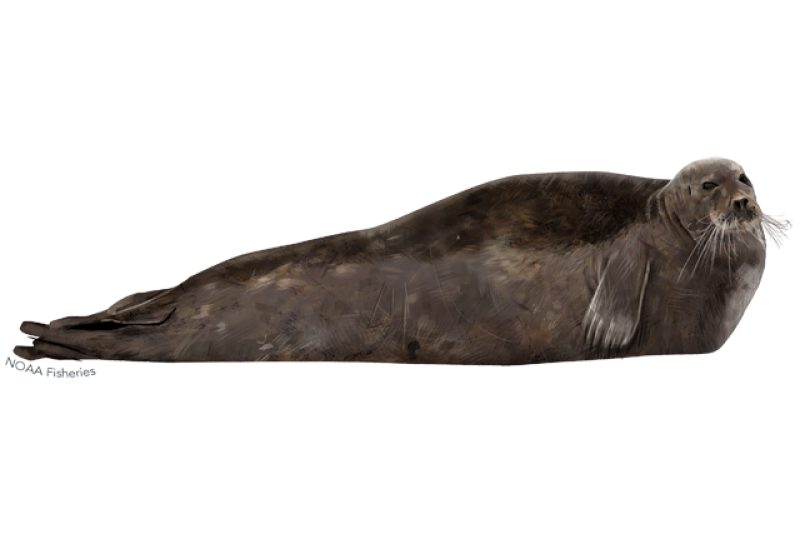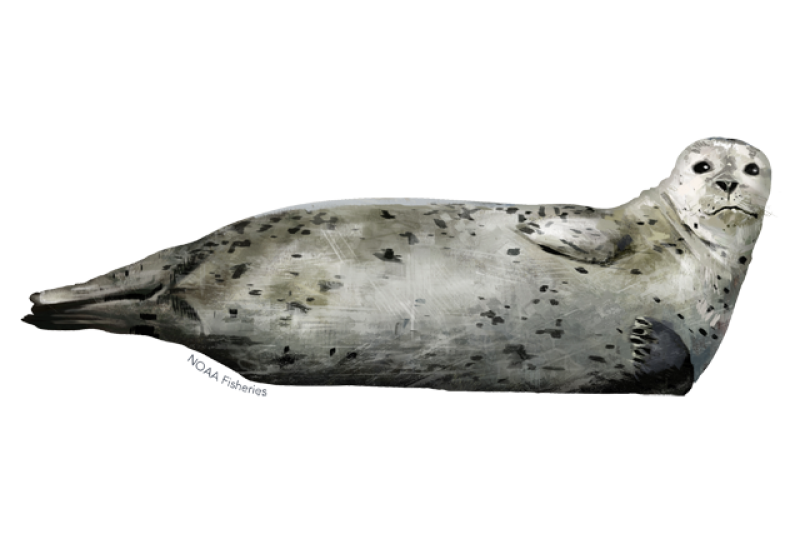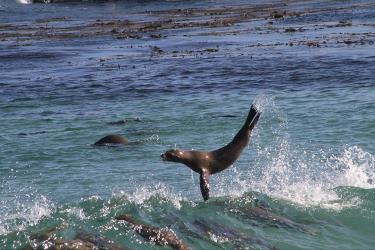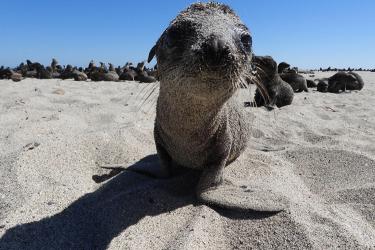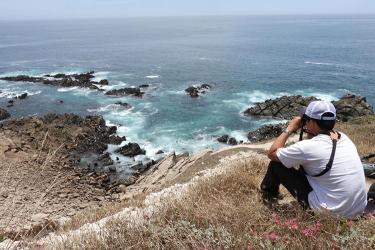Northern Elephant Seal
Mirounga angustirostris

Protected Status
Quick Facts
 Northern elephant seal. Photo: NOAA Fisheries
Northern elephant seal. Photo: NOAA Fisheries
Northern elephant seal. Photo: NOAA Fisheries
About the Species
 Northern elephant seal. Photo: NOAA Fisheries
Northern elephant seal. Photo: NOAA Fisheries
Northern elephant seal. Photo: NOAA Fisheries
The northern elephant seal is the largest of the “true” seals in the Northern Hemisphere. Adult males use their large, inflatable noses during the winter breeding season to resonate sound when vocally threatening each other. The largest colonies of northern elephant seals are found off southern California in the Channel Islands. They have one of the longest migrations of any mammal; some have been recorded traveling over 13,000 miles roundtrip.
Northern elephant seals were once thought to be extinct due to commercial sealing in the 1800s. A small population survived in Mexico and the population began to steadily increase in the early 1900s. Today, robust populations of northern elephant seals in the U.S. and Mexico are derived from those few hundred individuals that survived in Mexico.
Northern elephant seals, like all marine mammals, are protected by the Marine Mammal Protection Act.
Population Status
Though a complete population count of elephant seals is not possible because all age classes are not ashore at the same time, the most recent stock assessment reports with population estimates are available. Most (~80%) of the U.S. population of elephant seals reside at the Channel Islands. The minimum population size for this stock in 2013 was conservatively estimated at around 85,000 seals.
Appearance
Northern elephant seal pups are black until they are weaned at about 6 weeks old, and they molt and turn light silver. Adults are dark brown or gray.
When males reach puberty at about 7 years old, they develop a large inflatable nose, or "proboscis." The proboscis overhangs their lower lip by about 8 inches. They also develop a robust, thick neck with calloused skin that appears pink and light gray and creates a shield to protect them from harm when fighting other males. Conversely, females maintain their smaller noses and smooth necks.
Fully grown males can reach lengths of over 13 feet and can weigh nearly 4,400 pounds. Females are significantly smaller than males, but are also quite large, growing to about 10 feet long and weighing up to 1,300 pounds.
Behavior and Diet
Northern elephant seals’ diet primarily consists of squid and fishes, but they also consume rays and sharks.
Northern elephant seals spend about 9 months of the year in the ocean. Most of this time is underwater, diving to depths of about 1,000 to 2,500 feet for 20 to 30 minute intervals with only short breaks at the surface. They are rarely seen out at sea for this reason. While on land, they prefer sandy beaches.
Northern elephant seals fast during the mating season and can lose up to 36 percent of their body weight during this time. When molting occurs, they shed their short, dense fur along with large patches of old skin. Molting takes 4 to 5 weeks to complete.
Where They Live
Northern elephant seals are found in the eastern and central North Pacific Ocean. Though they range as far north as Alaska, they typically breed and give birth in the Channel Islands off California or Baja California in Mexico, primarily on offshore islands from December to March. Males feed near the eastern Aleutian Islands and in the Gulf of Alaska, and females feed farther south, in the offshore waters of Washington and Oregon. Adults return to land between March and August to molt, with males returning later than females. Adults return to their feeding areas again between the spring/summer molt and the winter breeding season.
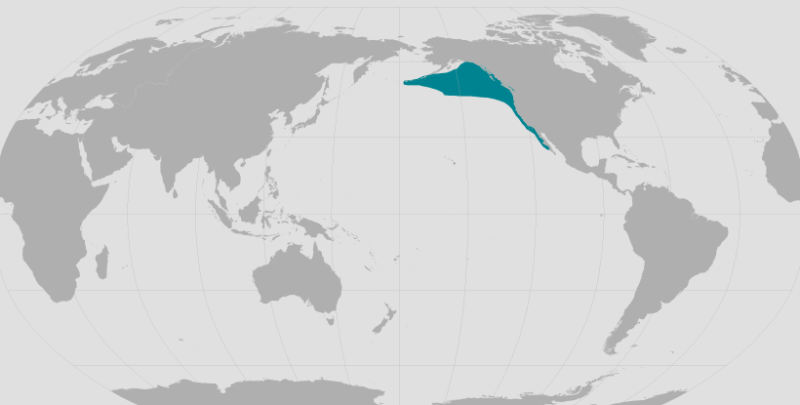 World map providing approximate representation of the northern elephant seal's range
World map providing approximate representation of the northern elephant seal's range
Lifespan & Reproduction
Pups are born in early winter from December to January. Breeding occurs from December to March, and gestation lasts around 11 months. Northern elephant seals are polygynous breeders with a social hierarchy. Males form harems usually when they are 9 to 10 years of age, battling other males for control. Adult males use their large, inflatable noses during the winter breeding season to resonate sound when vocally threatening each other.
There is a notable difference in lifespan between males and females. Females generally live for about 19 years, while males only live for about 13 years.
Females come ashore and within a few days give birth to a pup conceived in the previous breeding season. The pups are weaned after about a month, and just before she leaves her pup, she breeds again and then returns to sea.
Threats
Entanglement in Fishing Gear
Northern elephant seals can become entangled in fishing gear, either swimming off with the gear attached or becoming anchored and possibly drown if they cannot reach the surface to breathe. Once entangled, seals may drag and swim with attached gear for long distances, ultimately resulting in fatigue, compromised feeding ability, or severe injury, which may lead to reduced reproductive success, lower survival rates and/or death. They occasionally get hooked on fishing gear (hooks), particularly if live bait is being used, such as squid and small schooling fish.
Vessel Strikes
Inadvertent vessel strikes can injure or kill seals. The projected increase in vessel traffic arising from the opening of trans-polar shipping routes (as arctic sea ice continues to decline) will increase the risk of vessel strikes and also increase ambient noise and pollution.
Scientific Classification
| Kingdom | Animalia | Phylum | Chordata | Class | Mammalia | Order | Carnivora | Family | Phocidae | Genus | Mirounga | Species | angustirostris |
|---|
Last updated by NOAA Fisheries on 04/14/2025
What We Do
Conservation & Management
NOAA Fisheries is committed to protecting northern elephant seals. Targeted management actions taken to protect these seals include:
- Consulting with state and federal agencies to ensure proposed actions are unlikely to harm elephant seals due to the effects of entanglement in fishing gear or other stressors.
- Minimizing harassment and illegal feeding.
- Overseeing marine mammal health and stranding response.
- Educating the public, including fishers, about northern elephant seals and the threats they face.
Science
Our research projects have discovered new aspects of northern elephant seal biology, behavior, and ecology and have helped us better understand the challenges that all elephant seals face. Our work includes:
- Population assessments.
- Vital rates (survival and reproduction).
- Foraging ecology.
- Diet studies.
- Health and condition.
- Disease and contaminants.
How You Can Help
Report Marine Life in Distress
Report a sick, injured, entangled, stranded, or dead animal to make sure professional responders and scientists know about it and can take appropriate action. Numerous organizations around the country are trained and ready to respond. Never approach or try to save an injured or entangled animal yourself—it can be dangerous to both the animal and you.
Learn who you should contact when you encounter a stranded or injured marine animal
Keep Your Distance
Be responsible when viewing marine life in the wild. Observe all seals and sea lions from a safe distance of at least 50 yards and limit your time spent observing to 30 minutes or less.
Report a Violation
Call the NOAA Fisheries Enforcement Hotline at (800) 853-1964 to report a federal marine resource violation. This hotline is available 24 hours a day, 7 days a week for anyone in the United States.
You may also contact your closest NOAA Office of Law Enforcement field office during regular business hours.
Featured News
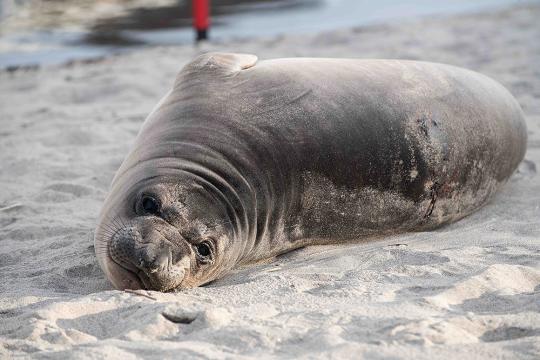 An elephant seal pup was stabbed multiple times in Oregon. Credit: Gregory Miller
An elephant seal pup was stabbed multiple times in Oregon. Credit: Gregory Miller
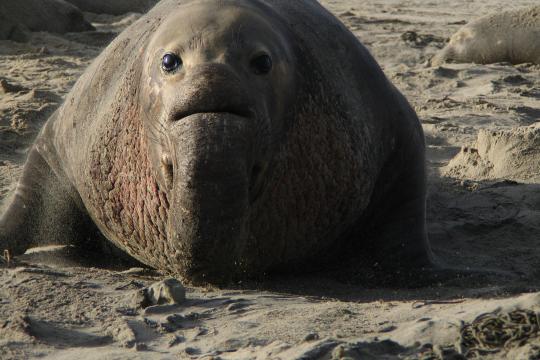 A male northern elephant seal. Credit: NOAA Fisheries/Mark Lowry
A male northern elephant seal. Credit: NOAA Fisheries/Mark Lowry
From Krill to Elephant Seals, Sentinel Species Detect Hidden Ocean Shifts that Forecast Change
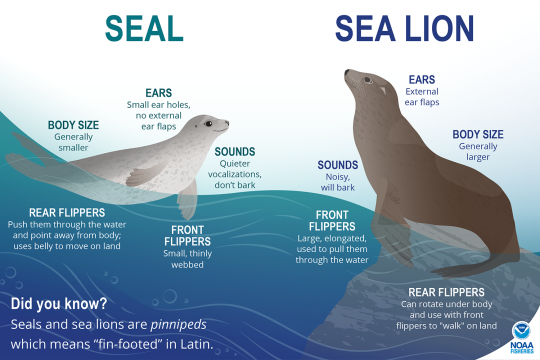 At first glance, seals (true or “earless seals”) and sea lions look fairly similar. Taking a closer look, these are some of the general differences to tell these animals, such as on the harbor seal (left) and California sea lion (right) pictured above.
At first glance, seals (true or “earless seals”) and sea lions look fairly similar. Taking a closer look, these are some of the general differences to tell these animals, such as on the harbor seal (left) and California sea lion (right) pictured above.
Is It a Seal or a Sea Lion?
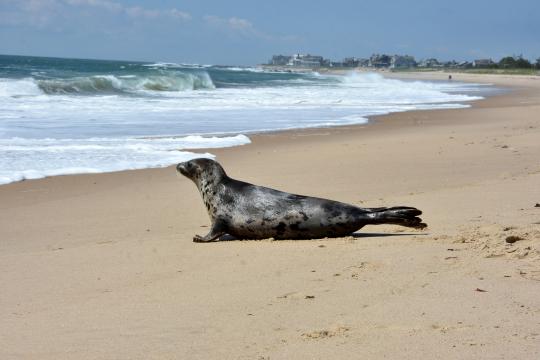 "Seuss," a juvenile harp seal, was released on Blue Shutters Beach, Rhode Island, following successful rehabilitation at Mystic Aquarium. Credit: Mystic Aquarium
"Seuss," a juvenile harp seal, was released on Blue Shutters Beach, Rhode Island, following successful rehabilitation at Mystic Aquarium. Credit: Mystic Aquarium
Management Overview
The northern elephant seal is protected throughout its range under the Marine Mammal Protection Act.

Conservation Efforts
Minimizing Harassment and Illegal Feeding
As human interactions with seals and sea lions increase, so does the risk of disturbing or injuring these animals. For seals and sea lions that rest on our beaches, close encounters with people may be harmful. Continued disturbances may cause mothers to abandon their pups. This species will haul out during molting season and may stay in the same area for weeks at a time. When they are molting they look like they are in very poor shape, but this is normal. Please do not attempt to approach these animals or interact with them in any way.
Learn more about how to safely and responsibly view seals and sea lions
Learn more about the rules regarding feeding and harassing marine mammals in the wild
Reducing Interactions with Fishing Gear
Northern elephant seals can get entangled in fishing gear, causing injury and possibly death. NOAA Fisheries is working to better understand and characterize the frequency, geographic extent, and magnitude of these interactions. We are also working with researchers to identify and evaluate ways to safely and effectively reduce the potential for these interactions and/or minimize injuries.
Learn more about bycatch and fisheries interactions
Overseeing Marine Mammal Health and Stranding Response
We work with volunteer networks in all coastal states to respond to marine mammal strandings including all pinnipeds. When stranded animals are found alive, NOAA Fisheries and our partners assess the animal’s health and determine the best course of action. When stranded animals are found dead, our scientists work to understand and investigate the cause of death. Although the cause often remains unknown, scientists can sometimes attribute strandings to disease, harmful algal blooms, vessel strikes, fishing gear entanglements, pollution exposure, and underwater noise. Some strandings can serve as indicators of ocean health, giving insight into larger environmental issues that may also have implications for human health and welfare.
Learn more about the Marine Mammal Health and Stranding Response Program
Marine Mammal Unusual Mortality Events (UMEs)
Northern Elephant Seals have never been part of a declared unusual mortality event. Under the Marine Mammal Protection Act, an unusual mortality event is defined as "a stranding that is unexpected; involves a significant die-off of any marine mammal population; and demands immediate response." To understand the health of marine mammal populations, scientists study unusual mortality events.
Key Actions and Documents
Last updated by NOAA Fisheries on 04/14/2025
Science Overview
NOAA Fisheries conducts various research activities on the biology, behavior, and ecology of the northern elephant seal. The results of this research are used to inform management decisions and ensure stable population levels for this species.
Population/Stock Assessments
Determining the number of northern elephant seals in each population—and whether a stock is increasing or decreasing over time—helps resource managers assess the success of enacted conservation measures. Our scientists collect information and present these data in annual stock assessment reports.
Additional Research
Scientists in our Marine Mammal Laboratory conduct wide-ranging research on the biology, life history, and health of northern elephant seals including:
- Vital rates (survival and reproduction).
- Distribution and migration.
- Diet/foraging ecology.
- Threats such as disease, contaminants,and entanglement.
Learn about our northern elephant seal research

More Information
Recent Science Blogs
Last updated by NOAA Fisheries on 04/14/2025
